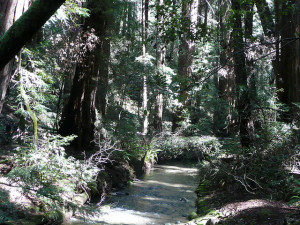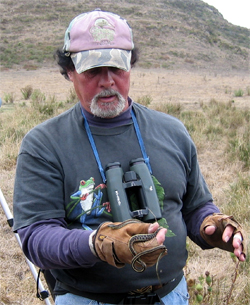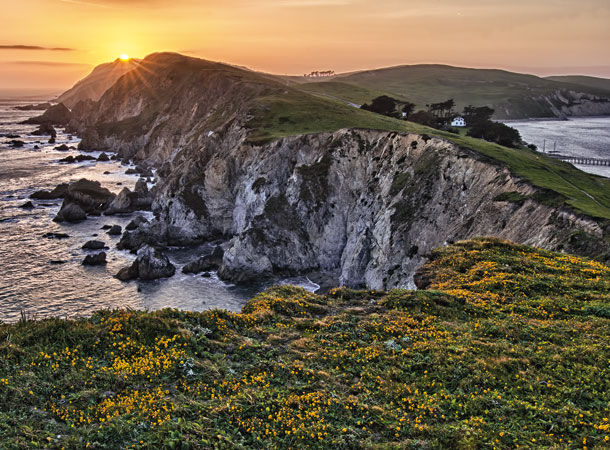On the very edge of the North American tectonic plate, surrounded by ranches and wetlands and everyone’s favorite park — Point Reyes National Seashore — sits the town of Point Reyes Station. And in the center of town (it’s all the center, really—it’s small) sits Point Reyes Books. And at the helm of the store sit Steve Costa and his wife Kate Levinson. A community organizer, former Congressional staffer, activist and board member of more than several environmental and cultural organizations (including the Point Reyes National Seashore Association and Heyday), Steve has a vision for the bookstore that is considerably broader than just selling books. Among the many community programs the bookstore sponsors, The Geography of Hope is a gathering of academics, writers, artists, ranchers, environmentalists, community builders, students, and the well-intentioned and curious public. The theme of this year’s conference is “Igniting the Green Fire: Finding Hope in Aldo Leopold’s Land Ethic.” I spoke recently with Steve about his life, his work, and the upcoming conference.
BN: How did you end up here? Have you always lived in the Bay Area?
Costa: I was born in Oakland, and when I was six months old my family moved to a small tract house in San Leandro. So I have long, deep roots in this area. My parents also grew up in the East Bay – it‘s was home to them as well. One of my grandmothers was born in San Francisco. My grandfather was Syrian. He came to the United States at the age of 16 to find opportunity, traveled across the country, and established a dry goods business. My other set of grandparents was of Portuguese-Azorean descent. They were born in Hawaii, worked in the sugar cane fields, and moved to California.
BN: You do so many things. What is your background, and how did it lead to your current work?
Costa: I have background as a community organizer. When I was 19, I quit college and became a VISTA volunteer. I went to the South Bronx, where I trained with Saul Alinsky’s protégés. I did my year of service in Providence, RI. During that year, I developed skills that I would use throughout my whole life, helping communities to organize and exert pressure on certain institutions around issues such as housing and health issues. We also worked with Brown University to create the first set of University-Community projects, including bringing university students to tutor students in the community.
Even though I don’t speak Portuguese, I looked the part, so I was assigned to Portuguese neighborhoods in Providence. When I returned home, I didn’t go back to school; I was too interested in neighborhood and community organizing. So I got involved in Pete Stark’s political campaign and ended up as a congressional staffer for six years.
I hadn’t done environmental work before, but while I was working for Stark I had a meeting with the Trust for Public Land (TPL), which wanted to convert empty lots into community gardens and parks and help communities start land trusts. I met with Huey Johnson, TPL’s President, and later that day, Huey invited me to create a demonstration project in Oakland. I agreed, and within three years we had established 40 gardens and seven land trusts. We had a good model which we brought to other cities around the country.
On my first day at TPL, Huey told me that Aldo Leopold’s Sand County Almanac was required reading. Its land ethic provided some of the basic values that guided me, and many others, in their environmental work.
Then, in 1989 our daughter Anna was killed in an automobile accident in the East Bay, shortly before her 17th birthday. Kate and I wanted to create a memorial for her, so we planted seventeen trees in Redwood Regional Park, bringing together friends to celebrate her birthday. It was a great event, very much a part of our healing process. So now, every year around her birthday, we plant the number of trees that represent her age, mostly in the East Bay Regional Parks, some at Bishop O’Dowd High School. So far we’ve planted a thousand trees.
BN: So how did you get from doing environmental work to running a bookstore?
Costa: During our healing process after this loss, we would go visit a friend who had a house in Inverness. Soon we fell in love with the area and decided we wanted to buy property here. We sold our house in Oakland and bought a house in Inverness.
At first, we were pretty anonymous. We used to frequent the Brown Study, a small bookshop in Point Reyes Station that mostly sold used books, and we became friends with the owner. One evening she mentioned she was going to sell the bookstore. Without any retail experience I decided to buy the store. That was ten years ago.
The bookstore also now serves as a “front” for my other community organizing activities. In the last ten years we’ve raised a quarter of a million dollars for various projects through author events and other programs. And now we’re about to put on the fourth Geography of Hope Conference, which is a cultural-environmental gathering focusing on the relationship between place, community, and literature.
BN: What is the focus of this year’s conference?
Costa: About a year and a half ago, U.S. Forest Service filmmakers Steven and Anne Dunsky produced a film, Igniting the Green Fire, explaining who Aldo Leopold is and how his work has influenced conservationists. The filmmakers, who are based in the Bay Area, approached me about a screening of the film, and one thing led to another. The conference will be the first West Coast gathering of the world’s foremost Aldo Leopold experts and will include field trips to the National Seashore and local farms and ranches to give participants the opportunity to experience Leopold’s land ethic directly. And of course, we’ll be showing the film and hearing from the filmmakers.
BN: I imagine you carry the Sand County Almanac in the store? How does it sell?
Costa: We always have a copy of Sand County Almanac in the store. Before the announcement of the conference a few months ago, we’d sold perhaps three dozen over the years. But since then, we’ve sold another 50 or so.
BN: What has come out of these Geography of Hope conferences?
Costa: The conferences are as much about relationships as they are about anything else: two to three hundred people in a small coastal town, challenged by stimulating presentations, with the opportunity to talk to people from this and other communities about the geography of hope. When people walk away, they have deeply interacted with both the presenters and the other participants. It reinforces their passion about the environment, and often moves them to act on environmental and conservation issues.
BN: I can probably guess your answer, but what is your favorite outdoor destination in the Bay Area?
Costa: Right in my own backyard—Point Reyes National Seashore!
The Geography of Hope Conference will take place on March 15, 16, and 17 in Point Reyes Station. The weekend features spirited presentations by, and conversations with, prominent authors, naturalists, and conservation leaders, including Aldo Leopold biographer Curt Meine, Aldo Leopold Foundation director Buddy Huffaker, Leopold scholars J. Baird Callicott and Susan Flader, poet Robert Hass, authors Gary Nabhan and John Francis, and Center for Whole Communities founder Peter Forbes. For tickets and more details, go to www.ptreyesbooks.com





